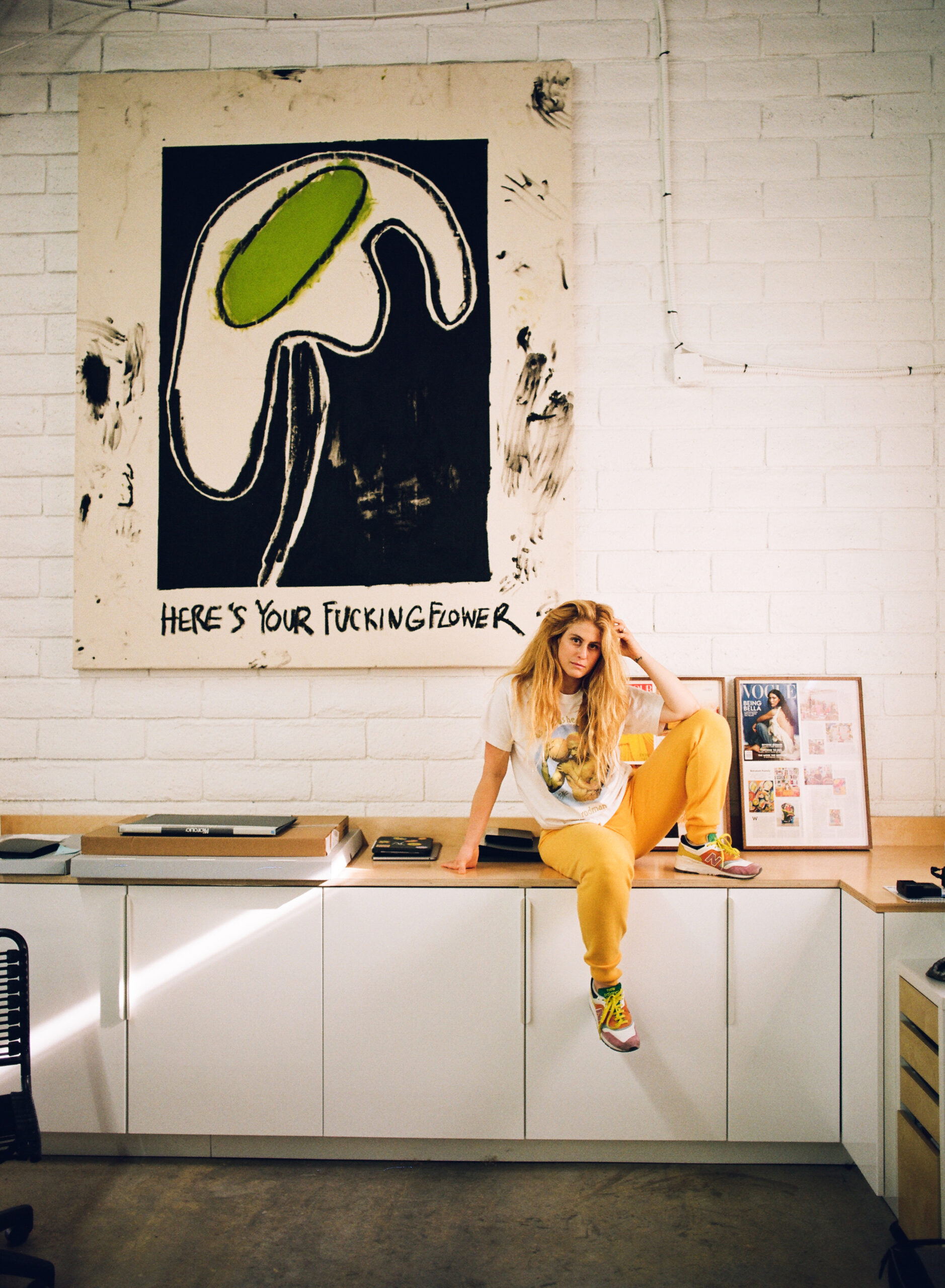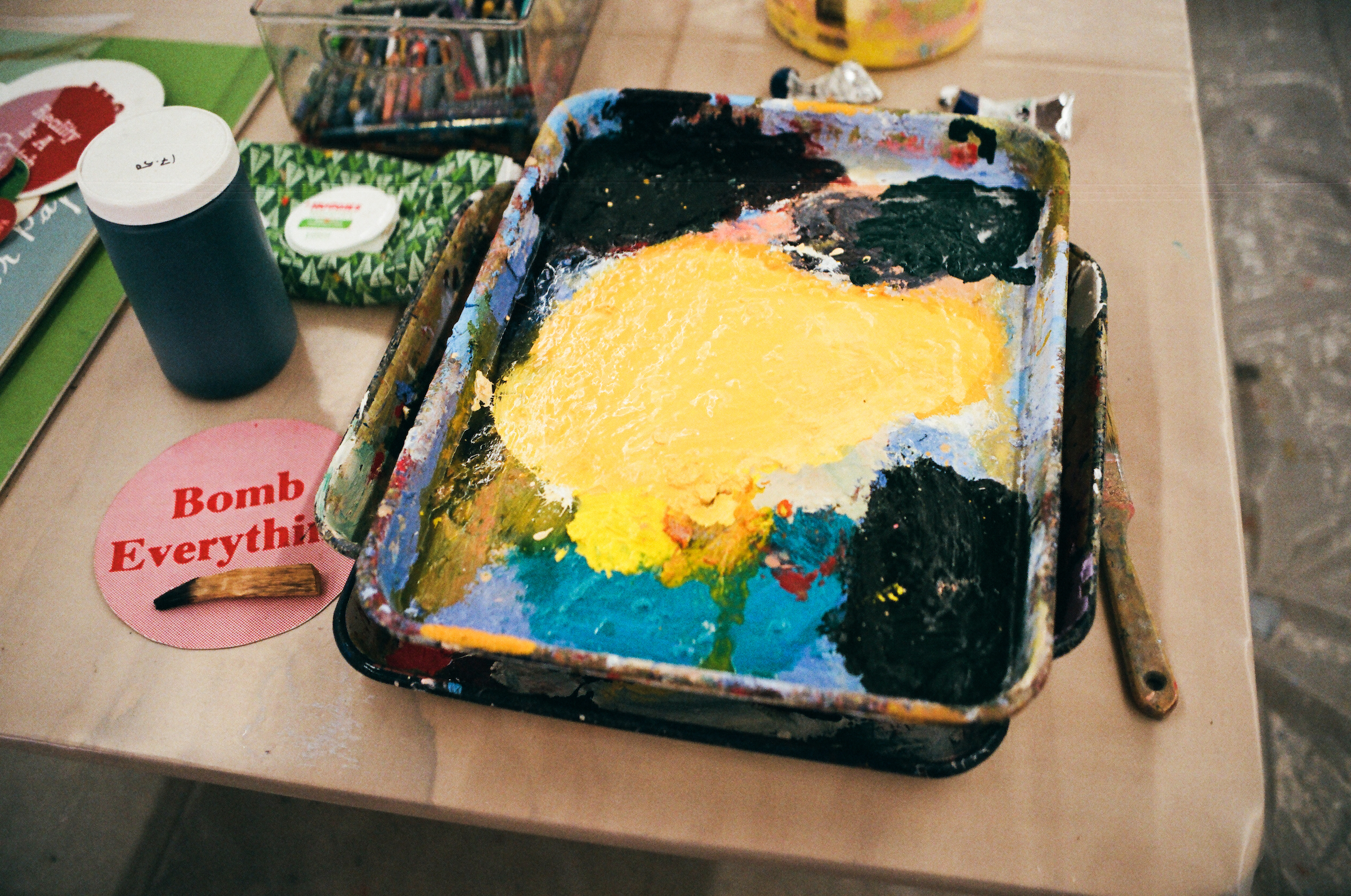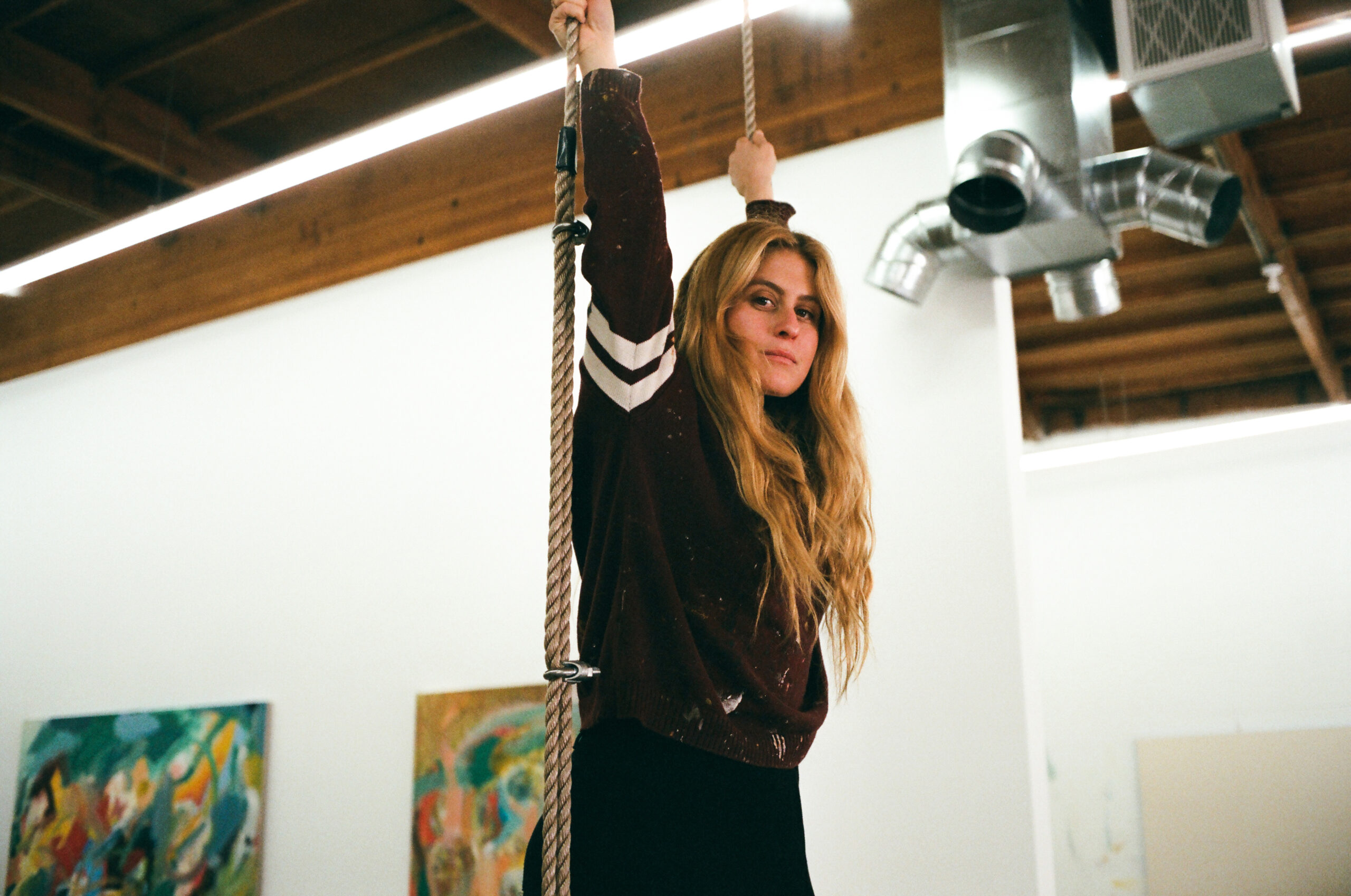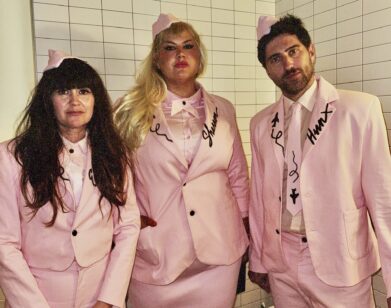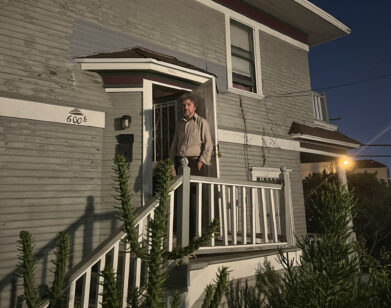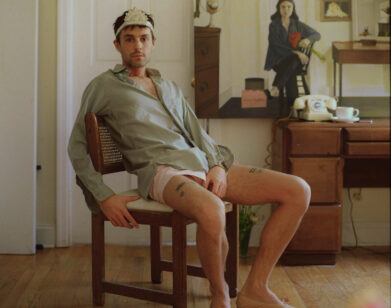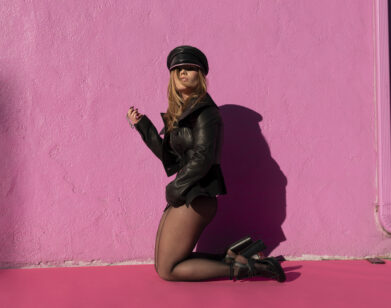IN STUDIO
Painter Austyn Weiner on Loneliness, Los Angeles, and Limitations
For Los Angeles-based artist Austyn Weiner, painting is a process of inward exploration, fueled by matcha, bone broth, and Palo Santo. The artist won’t pick up a paintbrush in the studio until she has consumed her “beverages” and has “lit something,” Palo Santo being a somewhat recent substitute for a spliff. Weiner’s unique studio practice is routine, but her process leaves room for experimentation and spontaneity. Her large-scale, abstract compositions are vibrant and bombastic, imbued with contemporary feminine narratives and historical references. Following an announcement of her representation by Massimo De Carlo Gallery, Weiner sat down with Interview to discuss her process, abstract expressionism, getting engaged, and why so many artists are alcoholics.
———
ALEX LEAV: Where are you from and when did you start painting?
AUSTYN WEINER: I’m from Miami. I went to the University of Michigan for a bit and lived in Tel Aviv, where I studied film. Then I moved to New York, where I attended Parsons. I lived in New York for four years and then moved to Los Angeles. There were bits of painting here and there throughout, but I started seriously painting when I got to L.A. I had never touched oil paint before I moved here.
LEAV: What does a typical day at the studio look like for you?
WEINER: A typical day at the studio now is a lot different than a typical day was when I first started painting. As I grow and change, my daily routine changes too. Now, I get to the studio in the morning and warm up. Like, I literally stretch my shoulders and do a little routine. Welcome to your 30s.
LEAV: That makes sense, though, because your work seems very physical. On some of your larger canvases, you must be using your entire wingspan to make a mark.
WEINER: Exactly. I’m throwing and wailing my arms around and standing for 11 hours a day. So, I warm up. Then I light some incense and make, like, three different types of beverages. I’ll make matcha, bone broth, and water with lemon. And I’m just guzzling these beverages basically the whole time I’m working.
LEAV: Very L.A.
WEINER: Yeah, it’s very L.A. It’s basically my replacement for walking into the studio, lighting a spliff, and smoking all day, which is what I used to do. So now it’s just drinking. Lighting incense and Palo Santo gives me that same feeling of “lighting” or starting something, which I love.
LEAV: And how do you start painting?
WEINER: Well, the amount of time I’m actually focused or have tunnel vision for one painting or one task is usually very small. I might come in, look around, see what happened the day before, the week before. I take a survey of the works and determine where I feel like things are. You have to be really brave in the studio to make any progress, and I’m not always brave. There are days I walk in circles, and I don’t even touch paint because I’m like, I can’t mess this up. Usually, though, I’ll pick one work to focus on and I’ll mix up a big tub of oil paint and I’ll start going at it. By the end of the day, that color will end up on most of the works in the studio.
LEAV: So you work on a few things at a time, in batches?
WEINER: I do. My practice scales up or down depending on the physical space I’m in. So, if I’m sitting on an airplane, for example, I’m working on a small drawing on the tray table in front of me. If I’m in a one-car garage, like my last studio, I’ll switch between two paintings. I’m in a huge warehouse-like studio now, though, so I work on multiple paintings, sometimes five or more at once. I sort of bounce back and forth, which is a totally different experience and mode of working. I don’t think either is better or worse than the other. It’s just different.
LEAV: What does it feel like to be subject to physical space?
WEINER: The physical nature of painting just makes it more exciting to me. The work is bigger than I am, and therefore I’m at the mercy of it. It intimidates me, which makes me rise to the occasion. I also think that smaller works are more challenging to me as a painter engaging with abstraction. On a large canvas, I’m able to utilize my full arm span, my whole body. It comes much more naturally to me when my full arm span can be one stroke on a painting because I don’t have to stop or limit myself.
LEAV: Can there be value in limiting yourself?
WEINER: Absolutely. I think there’s value in everything I’m not good at. One of the first pieces of advice I was ever given was to limit my color palette, to see what happened if I made a monochromatic painting. It’s interesting, because at the time, I was young and I was like no, fuck you, you know? But I’ve come back to that advice multiple times when I’ve been stuck in the studio and it’s what has really pushed my work forward.
LEAV: You seem to oscillate between figuration and abstraction, perhaps getting more abstract as of late?
WEINER: Yeah, my most recent work over the past year is probably the most abstract place I’ve gone. I think I’ll continue to work in both, though. Trying to make a unique abstraction is the hardest thing you can try to do.
LEAV: What do you mean by that?
WEINER: I mean, representational work isn’t easier to render by any means, but it’s easier to portray an idea or get an idea across because there’s existing representation for the idea. With abstraction, when there’s such a long lineage of artists who have set themselves on the exact same mission to create a unique abstraction and move paint in a way that no one has moved it before, it’s just so difficult.
LEAV: You mentioned a lineage of artists. Which artists do you really admire and look up to?
WEINER: There are so many. Learning about the Abstract Expressionists and the New York School in college was the first time that I was like, oh, lightning bolt! This is where my soul resides. I think there are a lot of parallels in our world now to the world during that period of time, which is why I think I’m so drawn to the work. I would say Lee Krasner, William de Kooning, Joan Mitchell, Phillip Guston. Pollock’s early abstractions also definitely feel very close to me and what I’m referencing. Also, in the present day, it’s interesting to see who’s playing in the same arena. For example, I love Spencer Lewis’s work. It becomes this team thing, when you start to see your peers making work in a similar language that you are. It’s pretty exciting, actually.
LEAV: Your work has a visible copy-and-paste or Photoshop clone-stamp feel. Kidney bean-shaped forms look almost copy-and-pasted throughout the canvas.
WEINER: For sure. I think of Laura Owens with that, too. She’s also a huge inspiration to me. Owens is the first artist that I was exposed to who was making paintings and referencing artists of the past but doing so in a very current way.
LEAV: You reference and engage with the digital, but your paintings feel so human to me.
WEINER: Thank you. My point in painting is to be human, to explore and record the human experience. I think that living in L.A. helps with this, by the way.
LEAV: Why L.A.?
WEINER: The sunshine, the weather, the solitude. The environment makes it a little bit easier to be an artist and go through the things every artist goes through.
LEAV: Do you let literature or film impact your work?
WEINER: I read now. When I was really starting out, though, I wouldn’t even read books. I would tell myself, “you need to write the books you want to read.” So, I wrote journals. Tons and tons of journals. When I needed inspiration, I’d look through my own journals. I still do. I was stuck a few months ago and I went back into my journals and found the ideas that I’m now working on for my show. Of course, there are times where I need to be out in the world, soaking it up and taking it all in, of course. But when I’m in my studio, I really don’t read or look at or listen to or watch anything from the outside world.
LEAV: It’s like that Guston quote: “When you’re in the studio painting, there are a lot of people in there with you—your teachers, friends, painters from history, critics. And one by one, if you’re really painting, they walk out. And if you’re really painting, you walk out.”
WEINER: Exactly. I couldn’t relate more to that quote.
LEAV: Are you ever lonely in the studio?
WEINER: I’m forever lonely. It’s also interesting because I’m recently engaged.
LEAV: Oh! Congratulations.
WEINER: Thank you. Since I’ve been painting at the level I’m painting at now and the frequency I’m painting at now, though, I haven’t been in a relationship. So, this is new to me. To feel that same loneliness while being in a relationship just even more so proves that what occurs in the studio is so personal and unexplainable. Like, there is literally no remedy for it. It’s why there’ve been so many alcoholic artists throughout history.
LEAV: [Laughs] Totally.
WEINER: I think loneliness is important, though. It’s hard and I don’t love suffering through it, but it’s important.
LEAV: Lastly, what is it about creating that you love?
WEINER: Freedom. I’m totally addicted to freedom and the constant fight for that freedom. I think that idea of a boundary-less, limitless space is something I’m constantly seeking. I have this weird addiction to seeking it, when innately it doesn’t come naturally to me.
LEAV: And, as an artist, that addiction will last forever. Kind of like the loneliness thing.
WEINER: [Laughs] Forever.

